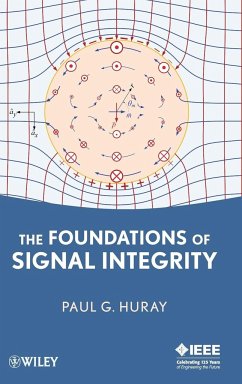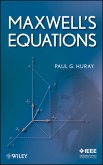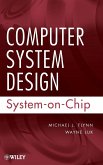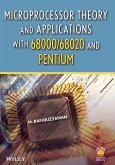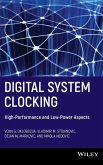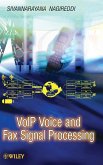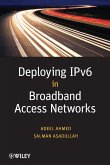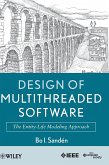Paul G Huray
The Foundations of Signal Integrity
Paul G Huray
The Foundations of Signal Integrity
- Gebundenes Buch
- Merkliste
- Auf die Merkliste
- Bewerten Bewerten
- Teilen
- Produkt teilen
- Produkterinnerung
- Produkterinnerung
Understanding of Signal Integrity is crucial in modern high speed applications. Based on the author's cutting edge research, Maxwell's Equations is the first book based on the electromagnetic basis of Signal Integrity rather than on empirical design. Covering all the necessary electromagnetic theory needed for a complete understanding of signal integrity, the book provides senior undergraduate and junior graduate students with a solid foundation in this burgeoning field. The book includes a problems and a solutions manual.
Andere Kunden interessierten sich auch für
![Maxwell's Equations Maxwell's Equations]() Paul G HurayMaxwell's Equations150,99 €
Paul G HurayMaxwell's Equations150,99 €![Computer System Design Computer System Design]() Michael J. FlynnComputer System Design94,99 €
Michael J. FlynnComputer System Design94,99 €![Microprocessor Theory and Applications with 68000/68020 and Pentium Microprocessor Theory and Applications with 68000/68020 and Pentium]() Mohamed RafiquzzamanMicroprocessor Theory and Applications with 68000/68020 and Pentium188,99 €
Mohamed RafiquzzamanMicroprocessor Theory and Applications with 68000/68020 and Pentium188,99 €![Digital System Clocking Digital System Clocking]() Digital System Clocking166,99 €
Digital System Clocking166,99 €![VoIP Voice and Fax VoIP Voice and Fax]() Sivannarayana NagireddiVoIP Voice and Fax167,99 €
Sivannarayana NagireddiVoIP Voice and Fax167,99 €![Deploying Ipv6 in Broadband Access Networks Deploying Ipv6 in Broadband Access Networks]() Adeel AhmedDeploying Ipv6 in Broadband Access Networks90,99 €
Adeel AhmedDeploying Ipv6 in Broadband Access Networks90,99 €![Design of Multithreaded Software Design of Multithreaded Software]() Bo I SandenDesign of Multithreaded Software117,99 €
Bo I SandenDesign of Multithreaded Software117,99 €-
-
-
Understanding of Signal Integrity is crucial in modern high speed applications. Based on the author's cutting edge research, Maxwell's Equations is the first book based on the electromagnetic basis of Signal Integrity rather than on empirical design. Covering all the necessary electromagnetic theory needed for a complete understanding of signal integrity, the book provides senior undergraduate and junior graduate students with a solid foundation in this burgeoning field. The book includes a problems and a solutions manual.
Hinweis: Dieser Artikel kann nur an eine deutsche Lieferadresse ausgeliefert werden.
Hinweis: Dieser Artikel kann nur an eine deutsche Lieferadresse ausgeliefert werden.
Produktdetails
- Produktdetails
- Verlag: John Wiley & Sons / Wiley
- Seitenzahl: 368
- Erscheinungstermin: 1. November 2009
- Englisch
- Abmessung: 240mm x 161mm x 24mm
- Gewicht: 710g
- ISBN-13: 9780470343609
- ISBN-10: 0470343605
- Artikelnr.: 26487749
- Herstellerkennzeichnung
- Libri GmbH
- Europaallee 1
- 36244 Bad Hersfeld
- gpsr@libri.de
- Verlag: John Wiley & Sons / Wiley
- Seitenzahl: 368
- Erscheinungstermin: 1. November 2009
- Englisch
- Abmessung: 240mm x 161mm x 24mm
- Gewicht: 710g
- ISBN-13: 9780470343609
- ISBN-10: 0470343605
- Artikelnr.: 26487749
- Herstellerkennzeichnung
- Libri GmbH
- Europaallee 1
- 36244 Bad Hersfeld
- gpsr@libri.de
Paul G. Huray, PhD, is Professor of Electrical Engineering at the University of South Carolina, where he has taught signal integrity, mathematical physics, and computer communications. Professor Huray introduced the first electromagnetics course to focus on signal integrity, and that program has produced more than eighty practicing signal integrity engineers now employed in academia, industry, and government. He earned his PhD in physics at the University of Tennessee in 1968, conducted research in the Solid State, Chemistry, and Physics Divisions at the Oak Ridge National Laboratory, and has worked part time for the Intel Corporation in developing the physical basis for barriers to circuits with bit rates up to 100 GHz.
Preface.
Intent of the Book.
1. Plane Electromagnetic Waves.
Introduction.
1.1 Propagating Plane Waves.
1.2 Polarized Plane Waves.
1.3 Doppler Shift.
1.4 Plane Waves in a Lossy Medium.
1.5 Dispersion and Group Velocity.
1.6 Power and Energy Propagation.
1.7 Momentum Propagation.
Endnotes.
2. Plane Waves in Compound Media.
Introduction.
2.1 Plane Wave Propagating in a Material as It Orthogonally Interacts with
a Second Material.
2.2 Electromagnetic Boundary Conditions.
2.3 Plane Wave Propagating in a Material as It Orthogonally Interacts with
Two Boundaries.
2.4 Plane Wave Propagating in a Material as It Orthogonally Interacts with
Multiple Boundaries.
2.5 Polarized Plane Waves Propagating in a Material as They Interact
Obliquely with a Boundary.
2.6 Brewster's Law.
2.7 Applications of Snell's Law and Brewster's Law.
Endnote.
3. Transmission Lines and Waveguides.
3.1 Infi nitely Long Transmission Lines.
3.2 Governing Equations.
3.3 Special Cases.
3.4 Power Transmission.
3.5 Finite Transmission Lines.
3.6 Harmonic Waves in Finite Transmission Lines.
3.7 Using AC Spice Models.
3.8 Transient Waves in Finite Transmission Lines.
4. Ideal Models vs Real-World Systems.
Introduction.
4.1 Ideal Transmission Lines.
4.2 Ideal Model Transmission Line Input and Output.
4.3 Real-World Transmission Lines.
4.4 Effects of Surface Roughness.
4.5 Effects of the Propagating Material.
4.6 Effects of Grain Boundaries.
4.7 Effects of Permeability.
4.8 Effects of Board Complexity.
4.9 Final Conclusions for an Ideal versus a Real-World Transmission Line.
Endnotes.
5. Complex Permittivity of Propagating Media.
Introduction.
5.1 Basic Mechanisms of the Propagating Material.
5.2 Permittivity of Permanent Polar Molecules.
5.3 Induced Dipole Moments.
5.4 Induced Dipole Response Function, G(¿).
5.5 Frequency Character of the Permittivity.
5.6 Kramers-Kronig Relations for Induced Moments.
5.7 Arbitrary Time Stimulus.
5.8 Conduction Electron Permittivity.
5.9 Conductivity Response Function.
5.10 Permittivity of Plasma Oscillations.
5.11 Permittivity Summary.
5.12 Empirical Permittivity.
5.13 Theory Applied to Empirical Permittivity.
5.14 Dispersion of a Signal Propagating through a Medium with Complex
Permittivity.
Endnotes.
6. Surface Roughness.
Introduction.
6.1 Snowball Model for Surface Roughness.
6.2 Perfect Electric Conductors in Static Fields.
6.3 Spherical Conductors in Time-Varying Fields.
6.4 The Far-Field Region.
6.5 Electrodynamics in Good Conducting Spheres.
6.6 Spherical Coordinate Analysis.
6.7 Vector Helmholtz Equation Solutions.
6.8 Multipole Moment Analysis.
6.9 Scattering of Electromagnetic Waves.
6.10 Power Scattered and Absorbed by Good Conducting Spheres.
6.11 Applications of Fundamental Scattering.
Endnotes.
7. Advanced Signal Integrity.
Introduction.
7.1 Induced Surface Charges and Currents.
7.2 Reduced Magnetic Dipole Moment Due to Field Penetration.
7.3 Infl uence of a Surface Alloy Distribution.
7.4 Screening of Neighboring Snowballs and Form Factors.
7.5 Pulse Phase Delay and Signal Dispersion.
Chapter Conclusions.
Endnotes.
8. Signal Integrity Simulations.
Introduction.
8.1 Defi nition of Terms and Techniques.
8.2 Circuit Simulation.
8.3 Transient SPICE Simulation.
8.4 Emerging SPICE Simulation Methods.
8.5 Fast Convolution Analysis.
8.6 Quasi-Static Field Solvers.
8.7 Full-Wave 3-D FEM Field Solvers.
8.8 Conclusions.
Endnotes.
Bibliography.
Index.
Intent of the Book.
1. Plane Electromagnetic Waves.
Introduction.
1.1 Propagating Plane Waves.
1.2 Polarized Plane Waves.
1.3 Doppler Shift.
1.4 Plane Waves in a Lossy Medium.
1.5 Dispersion and Group Velocity.
1.6 Power and Energy Propagation.
1.7 Momentum Propagation.
Endnotes.
2. Plane Waves in Compound Media.
Introduction.
2.1 Plane Wave Propagating in a Material as It Orthogonally Interacts with
a Second Material.
2.2 Electromagnetic Boundary Conditions.
2.3 Plane Wave Propagating in a Material as It Orthogonally Interacts with
Two Boundaries.
2.4 Plane Wave Propagating in a Material as It Orthogonally Interacts with
Multiple Boundaries.
2.5 Polarized Plane Waves Propagating in a Material as They Interact
Obliquely with a Boundary.
2.6 Brewster's Law.
2.7 Applications of Snell's Law and Brewster's Law.
Endnote.
3. Transmission Lines and Waveguides.
3.1 Infi nitely Long Transmission Lines.
3.2 Governing Equations.
3.3 Special Cases.
3.4 Power Transmission.
3.5 Finite Transmission Lines.
3.6 Harmonic Waves in Finite Transmission Lines.
3.7 Using AC Spice Models.
3.8 Transient Waves in Finite Transmission Lines.
4. Ideal Models vs Real-World Systems.
Introduction.
4.1 Ideal Transmission Lines.
4.2 Ideal Model Transmission Line Input and Output.
4.3 Real-World Transmission Lines.
4.4 Effects of Surface Roughness.
4.5 Effects of the Propagating Material.
4.6 Effects of Grain Boundaries.
4.7 Effects of Permeability.
4.8 Effects of Board Complexity.
4.9 Final Conclusions for an Ideal versus a Real-World Transmission Line.
Endnotes.
5. Complex Permittivity of Propagating Media.
Introduction.
5.1 Basic Mechanisms of the Propagating Material.
5.2 Permittivity of Permanent Polar Molecules.
5.3 Induced Dipole Moments.
5.4 Induced Dipole Response Function, G(¿).
5.5 Frequency Character of the Permittivity.
5.6 Kramers-Kronig Relations for Induced Moments.
5.7 Arbitrary Time Stimulus.
5.8 Conduction Electron Permittivity.
5.9 Conductivity Response Function.
5.10 Permittivity of Plasma Oscillations.
5.11 Permittivity Summary.
5.12 Empirical Permittivity.
5.13 Theory Applied to Empirical Permittivity.
5.14 Dispersion of a Signal Propagating through a Medium with Complex
Permittivity.
Endnotes.
6. Surface Roughness.
Introduction.
6.1 Snowball Model for Surface Roughness.
6.2 Perfect Electric Conductors in Static Fields.
6.3 Spherical Conductors in Time-Varying Fields.
6.4 The Far-Field Region.
6.5 Electrodynamics in Good Conducting Spheres.
6.6 Spherical Coordinate Analysis.
6.7 Vector Helmholtz Equation Solutions.
6.8 Multipole Moment Analysis.
6.9 Scattering of Electromagnetic Waves.
6.10 Power Scattered and Absorbed by Good Conducting Spheres.
6.11 Applications of Fundamental Scattering.
Endnotes.
7. Advanced Signal Integrity.
Introduction.
7.1 Induced Surface Charges and Currents.
7.2 Reduced Magnetic Dipole Moment Due to Field Penetration.
7.3 Infl uence of a Surface Alloy Distribution.
7.4 Screening of Neighboring Snowballs and Form Factors.
7.5 Pulse Phase Delay and Signal Dispersion.
Chapter Conclusions.
Endnotes.
8. Signal Integrity Simulations.
Introduction.
8.1 Defi nition of Terms and Techniques.
8.2 Circuit Simulation.
8.3 Transient SPICE Simulation.
8.4 Emerging SPICE Simulation Methods.
8.5 Fast Convolution Analysis.
8.6 Quasi-Static Field Solvers.
8.7 Full-Wave 3-D FEM Field Solvers.
8.8 Conclusions.
Endnotes.
Bibliography.
Index.
Preface.
Intent of the Book.
1. Plane Electromagnetic Waves.
Introduction.
1.1 Propagating Plane Waves.
1.2 Polarized Plane Waves.
1.3 Doppler Shift.
1.4 Plane Waves in a Lossy Medium.
1.5 Dispersion and Group Velocity.
1.6 Power and Energy Propagation.
1.7 Momentum Propagation.
Endnotes.
2. Plane Waves in Compound Media.
Introduction.
2.1 Plane Wave Propagating in a Material as It Orthogonally Interacts with
a Second Material.
2.2 Electromagnetic Boundary Conditions.
2.3 Plane Wave Propagating in a Material as It Orthogonally Interacts with
Two Boundaries.
2.4 Plane Wave Propagating in a Material as It Orthogonally Interacts with
Multiple Boundaries.
2.5 Polarized Plane Waves Propagating in a Material as They Interact
Obliquely with a Boundary.
2.6 Brewster's Law.
2.7 Applications of Snell's Law and Brewster's Law.
Endnote.
3. Transmission Lines and Waveguides.
3.1 Infi nitely Long Transmission Lines.
3.2 Governing Equations.
3.3 Special Cases.
3.4 Power Transmission.
3.5 Finite Transmission Lines.
3.6 Harmonic Waves in Finite Transmission Lines.
3.7 Using AC Spice Models.
3.8 Transient Waves in Finite Transmission Lines.
4. Ideal Models vs Real-World Systems.
Introduction.
4.1 Ideal Transmission Lines.
4.2 Ideal Model Transmission Line Input and Output.
4.3 Real-World Transmission Lines.
4.4 Effects of Surface Roughness.
4.5 Effects of the Propagating Material.
4.6 Effects of Grain Boundaries.
4.7 Effects of Permeability.
4.8 Effects of Board Complexity.
4.9 Final Conclusions for an Ideal versus a Real-World Transmission Line.
Endnotes.
5. Complex Permittivity of Propagating Media.
Introduction.
5.1 Basic Mechanisms of the Propagating Material.
5.2 Permittivity of Permanent Polar Molecules.
5.3 Induced Dipole Moments.
5.4 Induced Dipole Response Function, G(¿).
5.5 Frequency Character of the Permittivity.
5.6 Kramers-Kronig Relations for Induced Moments.
5.7 Arbitrary Time Stimulus.
5.8 Conduction Electron Permittivity.
5.9 Conductivity Response Function.
5.10 Permittivity of Plasma Oscillations.
5.11 Permittivity Summary.
5.12 Empirical Permittivity.
5.13 Theory Applied to Empirical Permittivity.
5.14 Dispersion of a Signal Propagating through a Medium with Complex
Permittivity.
Endnotes.
6. Surface Roughness.
Introduction.
6.1 Snowball Model for Surface Roughness.
6.2 Perfect Electric Conductors in Static Fields.
6.3 Spherical Conductors in Time-Varying Fields.
6.4 The Far-Field Region.
6.5 Electrodynamics in Good Conducting Spheres.
6.6 Spherical Coordinate Analysis.
6.7 Vector Helmholtz Equation Solutions.
6.8 Multipole Moment Analysis.
6.9 Scattering of Electromagnetic Waves.
6.10 Power Scattered and Absorbed by Good Conducting Spheres.
6.11 Applications of Fundamental Scattering.
Endnotes.
7. Advanced Signal Integrity.
Introduction.
7.1 Induced Surface Charges and Currents.
7.2 Reduced Magnetic Dipole Moment Due to Field Penetration.
7.3 Infl uence of a Surface Alloy Distribution.
7.4 Screening of Neighboring Snowballs and Form Factors.
7.5 Pulse Phase Delay and Signal Dispersion.
Chapter Conclusions.
Endnotes.
8. Signal Integrity Simulations.
Introduction.
8.1 Defi nition of Terms and Techniques.
8.2 Circuit Simulation.
8.3 Transient SPICE Simulation.
8.4 Emerging SPICE Simulation Methods.
8.5 Fast Convolution Analysis.
8.6 Quasi-Static Field Solvers.
8.7 Full-Wave 3-D FEM Field Solvers.
8.8 Conclusions.
Endnotes.
Bibliography.
Index.
Intent of the Book.
1. Plane Electromagnetic Waves.
Introduction.
1.1 Propagating Plane Waves.
1.2 Polarized Plane Waves.
1.3 Doppler Shift.
1.4 Plane Waves in a Lossy Medium.
1.5 Dispersion and Group Velocity.
1.6 Power and Energy Propagation.
1.7 Momentum Propagation.
Endnotes.
2. Plane Waves in Compound Media.
Introduction.
2.1 Plane Wave Propagating in a Material as It Orthogonally Interacts with
a Second Material.
2.2 Electromagnetic Boundary Conditions.
2.3 Plane Wave Propagating in a Material as It Orthogonally Interacts with
Two Boundaries.
2.4 Plane Wave Propagating in a Material as It Orthogonally Interacts with
Multiple Boundaries.
2.5 Polarized Plane Waves Propagating in a Material as They Interact
Obliquely with a Boundary.
2.6 Brewster's Law.
2.7 Applications of Snell's Law and Brewster's Law.
Endnote.
3. Transmission Lines and Waveguides.
3.1 Infi nitely Long Transmission Lines.
3.2 Governing Equations.
3.3 Special Cases.
3.4 Power Transmission.
3.5 Finite Transmission Lines.
3.6 Harmonic Waves in Finite Transmission Lines.
3.7 Using AC Spice Models.
3.8 Transient Waves in Finite Transmission Lines.
4. Ideal Models vs Real-World Systems.
Introduction.
4.1 Ideal Transmission Lines.
4.2 Ideal Model Transmission Line Input and Output.
4.3 Real-World Transmission Lines.
4.4 Effects of Surface Roughness.
4.5 Effects of the Propagating Material.
4.6 Effects of Grain Boundaries.
4.7 Effects of Permeability.
4.8 Effects of Board Complexity.
4.9 Final Conclusions for an Ideal versus a Real-World Transmission Line.
Endnotes.
5. Complex Permittivity of Propagating Media.
Introduction.
5.1 Basic Mechanisms of the Propagating Material.
5.2 Permittivity of Permanent Polar Molecules.
5.3 Induced Dipole Moments.
5.4 Induced Dipole Response Function, G(¿).
5.5 Frequency Character of the Permittivity.
5.6 Kramers-Kronig Relations for Induced Moments.
5.7 Arbitrary Time Stimulus.
5.8 Conduction Electron Permittivity.
5.9 Conductivity Response Function.
5.10 Permittivity of Plasma Oscillations.
5.11 Permittivity Summary.
5.12 Empirical Permittivity.
5.13 Theory Applied to Empirical Permittivity.
5.14 Dispersion of a Signal Propagating through a Medium with Complex
Permittivity.
Endnotes.
6. Surface Roughness.
Introduction.
6.1 Snowball Model for Surface Roughness.
6.2 Perfect Electric Conductors in Static Fields.
6.3 Spherical Conductors in Time-Varying Fields.
6.4 The Far-Field Region.
6.5 Electrodynamics in Good Conducting Spheres.
6.6 Spherical Coordinate Analysis.
6.7 Vector Helmholtz Equation Solutions.
6.8 Multipole Moment Analysis.
6.9 Scattering of Electromagnetic Waves.
6.10 Power Scattered and Absorbed by Good Conducting Spheres.
6.11 Applications of Fundamental Scattering.
Endnotes.
7. Advanced Signal Integrity.
Introduction.
7.1 Induced Surface Charges and Currents.
7.2 Reduced Magnetic Dipole Moment Due to Field Penetration.
7.3 Infl uence of a Surface Alloy Distribution.
7.4 Screening of Neighboring Snowballs and Form Factors.
7.5 Pulse Phase Delay and Signal Dispersion.
Chapter Conclusions.
Endnotes.
8. Signal Integrity Simulations.
Introduction.
8.1 Defi nition of Terms and Techniques.
8.2 Circuit Simulation.
8.3 Transient SPICE Simulation.
8.4 Emerging SPICE Simulation Methods.
8.5 Fast Convolution Analysis.
8.6 Quasi-Static Field Solvers.
8.7 Full-Wave 3-D FEM Field Solvers.
8.8 Conclusions.
Endnotes.
Bibliography.
Index.

